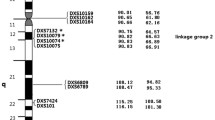Abstract
Application of X-STRs as complements of autosomal STR application in the forensic genetics has become a tendency for kinship testing, especially in deficiency paternity cases. Recently, a novel kit of 19 X-STR loci was developed, which permitted the analysis of 19 STR in the same PCR reaction, and these markers can be clustered into seven groups for the physical linkage. The objective of this study was to evaluate the allele and haplotype diversity of 19 X-STR loci in the Uygur (n = 220) and Tibetan nationality (n = 270) and to estimate the usefulness for complex kinship analysis. In the Tibetan and Uygur populations, a total of alleles of all loci were 188 and 212, with the allele frequencies ranged from 0.0037 to 0.5593 and from 0.0045 to 0.5409, respectively. Compared with previous studies, DXS10135 was the most polymorphic locus in the two population groups, whereas the least variant locus was DXS10164 in the Uygur population and DXS7423 in the Tibetan nationality. Haplotype diversity obtained in this investigation was greater than 0.9 across all LGs. This study indicated the new kit could be used as a supplementary tool in kinship testing in China. In addition, the data sets can be used as supplementary national X-STR references to enlarge the database.
Similar content being viewed by others
References
Szibor R (2007) X-chromosomal markers: past, present and future. Forensic Sci Int Genet 1:93–99
Prieto-Fernández E, Baeta M, Núñez C, Jiménez-Moreno S, de Pancorbo MM (2015) A new 17 X-STR multiplex for forensic purposes. Forensic Science International: Genetics Supplement Series 5:e283–e285
Nakamura Y, Samejima M, Tamaki K, Minaguchi K (2013) Multiplex PCR for 18 X-chromosomal STRs in Japanese population. Leg Med (Tokyo) 15:164–170
Gusmao L, Sanchez-Diz P, Alves C, Gomes I, Zarrabeitia MT, Abovich M, Atmetlla I, Bobillo C, Bravo L, Builes J et al (2009) A GEP-ISFG collaborative study on the optimization of an X-STR decaplex: data on 15 Iberian and Latin American populations. Int J Legal Med 123:227–234
Nothnagel M, Szibor R, Vollrath O, Augustin C, Edelmann J, Geppert M, Alves C, Gusmao L, Vennemann M, Hou Y et al (2012) Collaborative genetic mapping of 12 forensic short tandem repeat (STR) loci on the human X chromosome. Forensic Sci Int Genet 6:778–784
Luo HB, Ye Y, Wang YY, Liang WB, Yun LB, Liao M, Yan J, Wu J, Li YB, Hou YP (2011) Characteristics of eight X-STR loci for forensic purposes in the Chinese population. Int J Legal Med 125:127–131
Walsh BS, Petzger DA, Higuchi R (1991) Chelex-100 as medium for simple extraction of DNA for PCR-based typing from forensic material. BioTechniques 10:506–510
Zhu B, Liu S, Ci D, Huang J, Wang Y, Chen L, Zhu J, Xu Y, Zhao Q, Li S, Liu Y (2006) Population genetics for Y-chromosomal STRs haplotypes of Chinese Tibetan ethnic minority group in Tibet. Forensic Sci Int 161:78–83
Song F, Luo HB, Hou YP (2014) Population data of 21 non-CODIS STR loci in the Chinese Uygur ethnic minority. Forensic Sci Int Genet 13:e1–e2
Excoffier L, Lischer HE (2010) Arlequin suite ver 3.5: a new series of programs to perform population genetics analyses under Linux and Windows. Mol Ecol Resour 10:564–567
Bini C, Riccardi LN, Ceccardi S, Carano F, Sarno S, Luiselli D, Pelotti S (2015) Expanding X-chromosomal forensic haplotype frequencies database: Italian population data of four linkage groups. Forensic Sci Int Genet 15:127–130
Guo YX, Chen JG, Wang Y, Yan JW, Chen J, Yao TH, Zhang LP, Yang G, Meng HT, Zhang YD et al (2016) Genetic polymorphism analyses of a novel panel of 19 X-STR loci in the Chinese Uygur ethnic minority. J Zhejiang Univ Sci B 17:367–374
Zhang YD, Shen CM, Meng HT, Guo YX, Dong Q, Yang G, Yan JW, Liu YS, Mei T, Huang RZ, Zhu BF (2016) Allele and haplotype diversity of new multiplex of 19 ChrX-STR loci in Han population from Guanzhong region (China). Electrophoresis 37:1669–1675
Acknowledgements
This work was supported by the National Natural Science Foundation of China (No. 81302623) and Outstanding Youth Fund of Sichuan University (No. 2016SCU04A07), and the authors would like to thank all contributors who supplied samples to the study.
Author information
Authors and Affiliations
Corresponding authors
Ethics declarations
The study procedures were approved by the Ethics Committee of Sichuan University, China.
Conflict of interest
The authors declare that they have no conflict of interest.
Additional information
Chuncao Deng and Feng Song contributed equally to this work.
Feng Song should be considered as co-first author.
Electronic supplementary material
Supplementary Table 1
(DOCX 27 kb)
Supplementary Table 2
(DOCX 31 kb)
Supplementary Table 3
(DOCX 17 kb)
Supplementary Table 4
(XLSX 25 kb)
Supplementary Table 5
(XLSX 24 kb)
Supplementary Table 6
(DOCX 16 kb)
Supplementary Fig. 1
(DOCX 1931 kb)
Supplementary Fig. 2
(DOCX 1080 kb)
Rights and permissions
About this article
Cite this article
Deng, C., Song, F., Li, J. et al. Forensic parameters of 19 X-STR polymorphisms in two Chinese populations. Int J Legal Med 131, 975–977 (2017). https://doi.org/10.1007/s00414-017-1538-1
Received:
Accepted:
Published:
Issue Date:
DOI: https://doi.org/10.1007/s00414-017-1538-1



